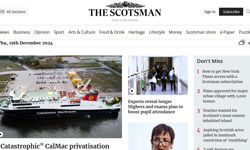WAN-IFRA is inviting newspapers to enter the 10th International Newspaper Color Quality Club competition, a once-every-two-years opportunity to help them fully exploit the enormous impact that good colour printing can have on readers and advertisers.
The Club is more than a contest; its program includes numerous tools to improve colour quality. Newspapers that make the short list of the world’s best-printed colour newspapers also increase their prestige among readers, pride among staff members, and – perhaps most importantly - benefits when it comes to selling ad space to fussy customers.
Registration for the 2012-2014 competition is now open, and there is a special bonus for early sign-ups. Those who register by 17 October 2011 will benefit from a free preliminary test evaluation. Click here for full details and registration information.
The first Club tutorial will be held 29 June in Darmstadt (see below for details). Please contact Ulrike Cremer, Manager WAN-IFRA Academy, at ulrike.cremer@wan-ifra.org to register.
The International Newspaper Colour Quality Club is the only worldwide printing quality competition for newspapers. Its goal is to improve the quality of reproduction and printing in production, while also increasing competitiveness as well as training and motivating all personnel. The competition has been held every two years since 1994. Newspapers that participate with success are awarded membership for a two-year period in the exclusive club of top-quality titles. Multiple winners and participants in the WAN-IFRA certification project also have the prospect of being awarded membership in the Star Club.
Participation in the contest can be easily integrated into a newspaper’s normal production operations. Participants download a small ad-like test element and incorporate it into a page – no costly, time-consuming special print runs are required.
According to WAN-IFRA, some of the benefits of participating are:
• Demonstrate consistent and reliable printing in accordance with exacting worldwide standards;
• Promote certification and gain an edge in the competition for readers and advertisers;
• Counter customer complaints more confidently;
• Increase quality awareness and know-how within the workforce;
• Define goals for production personnel and motivate them to achieve those goals; and
• Optimise materials on the basis of detailed evaluations.
Participation in the competition is open to all newspapers, independent of the production processes or types of paper that are used. Four categories have been defined:
• Coldset-offset printing on newsprint
• Heatset-offset printing or UV-cured offset printing on newsprint
• Heatset-offset printing or UV-cured offset printing on SC or LWC paper
• Extra category for newspaper printing on tinted paper or for printing processes other than offset (e.g. flexo or ink-jet)
Newspaper titles can be registered by publishing houses or by printing companies. Each title is considered as a separate participant. One company can register several titles.
As part of the Club program, WAN-IFRA offers a variety of tools to help prepress specialists, production and printing plant managers, and other personnel responsible for printing quality. One offering consists of tutorials in which contest participants learn in detail about the relevant ISO standards and contest rules.
These are the main topics of the tutorial:
• Importance, use and objectives of the Club
• Overview of procedure and time schedule
• Specifications of the ISO standard
• Expected changes in a new version of the newspaper printing standard in 2012
• Printing in accordance with the ISO coldset standard 12647-3: What this means!
• Participation categories and test charts
• Description of technical details
• Parameters for a successful participation
• Evaluation of measurements
• Utilities for checking quality in advance
• Judging the general printing quality










